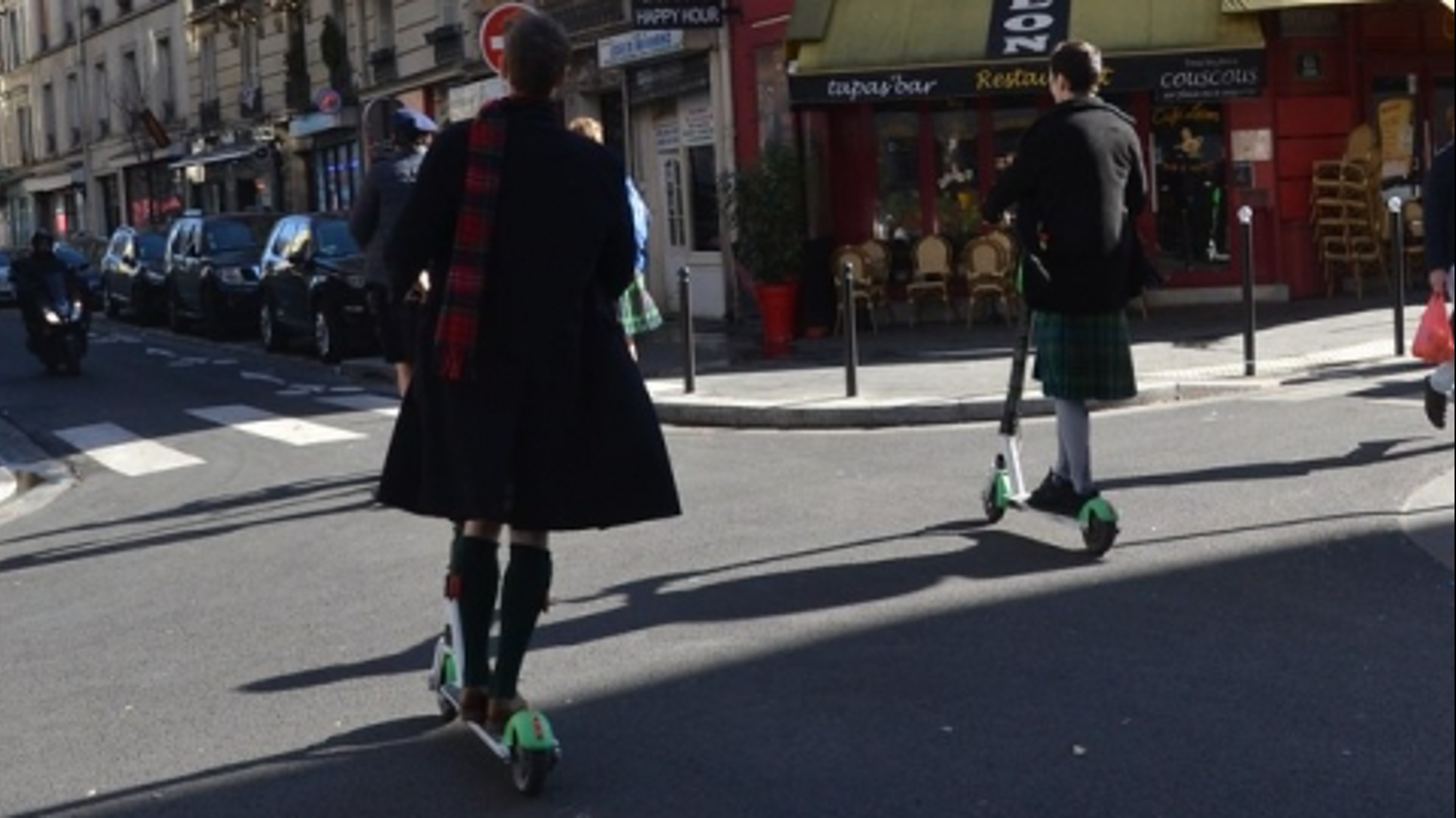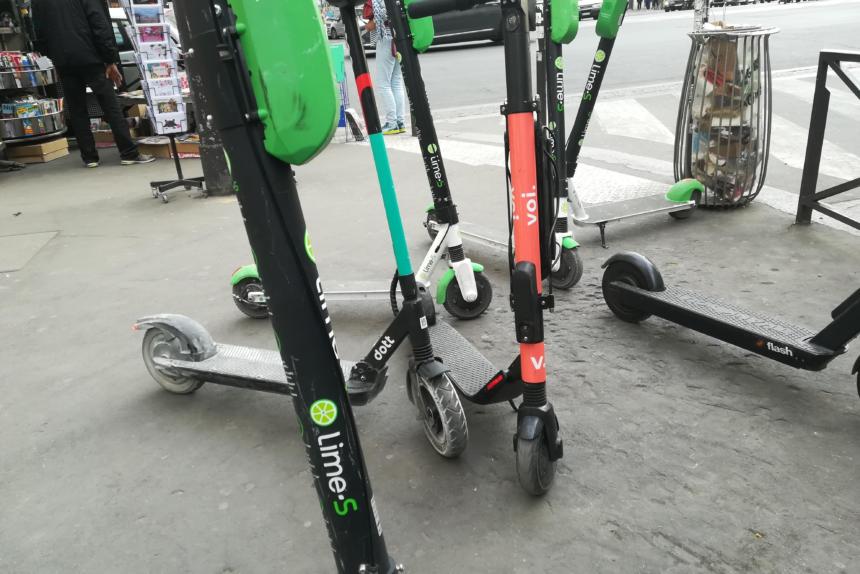
Blog post
E-scooters – the next big thing or just eco bling?
It’s a beautiful morning in Paris. Sun shining, a breeze relieving the oppressive heat of the past few days. Not a cloud in the sky. So why are there three people arguing with one another by the side of a pedestrian crossing? E-scooters.
With a green light and a car coming to a stop just ahead of a crossing, the mother with the pram and two pedestrians decide to step out. Out of nowhere, an e-scooter appears and nearly takes everyone out. I think I am usually quite calm, the other lady might say the same thing about herself, but both of us ended up remonstrating loudly with the “scooter-ist” who was very confident he had done nothing wrong (he had!).
Of course, any road user can break the rules or drive dangerously – but with the proliferation of e-scooters over recent months in Paris (at its peak there were 12 private operators, many more than most other cities) and regulation struggling to keep up, it’s easy to see why they can draw so much ire.
There are an estimated 20,000 plus e-scooters in Paris, so this tame story will just be one of hundreds (think about the impact of 20,000 of anything introduced rapidly to an environment not designed for it). No permit or training needed, it was possible to hop on one for a Euro or two, and, a twist of a handle later you are zipping along at 25km/h. For some it’s an expression of freedom, for others it’s a recipe for a disaster. As with many things, there is probably an undiscovered middle ground lurking somewhere out there.

In Paris, a regulatory crack-down has begun after the mayor described the situation as “anarchy”. Fines are now being imposed on users for misuse (speeding, riding on pavements, bad parking, etc.), and operators must ensure their scooters are not just left in the middle of pavements or dumped when broken. Although these measures are a brake on unchecked growth, they are not designed to eliminate e-scooters which are still very common in many neighbourhoods.
For an operator new regulation is a challenge in what has been their busiest market to date. For now, some Parisians might be breathing a sigh of relief – but is that the end of the story? Does the bubble simply pop when a city begins to regulate more closely, or should we look closer at what is going on?
Well, looking at their boom in popularity, the first question we need to ask is “why”? E-scooters provide an easy-to-use, personalised form of transport that is quick and requires minimal physical effort. Add to that their space-saving nature and you have something that provides some of the benefits of a car or a moped, but ostensibly more adapted to our increasingly congested city spaces. Not everyone is using them for practical means, but the idea that all users are just thrill-seeking tourists is inaccurate.
So far, so obvious – e-scooters are popular, but they annoy some people and need to be regulated. But what does this have to do with the Green Giraffe Energy Blog? A second anecdote might help us draw a more obvious link.
Walking along a side street the other week, I noticed the front door of an apartment propped open by a scooter. On closer inspection it was more like six or seven, all connected to the same multi-plug in the common area (i.e. the part where all residents in the block share the electricity bill). There are other stories of scooter batteries being charged by diesel generators.
It’s difficult to judge how many people use these scooters because they are perceived to be a more environmentally friendly option to a car or a regular scooter. That’s a rather complex behavioural economics question, but let’s assume that it plays a part in their popularity, even if the primary driver might be convenience. There seems to be an emerging consensus in personal transportation that electric powered things are all good, petrol- or diesel-powered things are all bad. Not many consumers are looking under the hood of this particular argument to see if it that is always the case.
At the risk of stating the blindingly obvious, plugging an electric scooter into a diesel generator isn’t green and using common space power sockets in apartment blocks isn’t going to make you friends with your neighbours. I would be surprised if the average user is thinking about that before activating their rental – the product in front of them is light and electronic, so ‘green’ on the face of it.
Clearly, it is much less so in reality if the source of power is not from a clean source, although in France at least with nuclear being the dominant generation, mains-charged scooters have a carbon-free source. Secondly, e-scooters seem to be viewed as a disposable option by users, having a limited lifespan before they need to be replaced (or end up in the Seine) – depending on the country of operation, the environmental impact of manufacturing and disposing can be the primary issue.
As the trend to electrifying transport gathers further pace, how will we ensure this is truly greener and enable our grids to cope with the impact? Many people assume electric cars are “green”, but the same point applies to their source of electricity as for e-scooters.
Battery sizes for scooters vary but using a mid-range 187 Wh battery and assuming each scooter does one full charge per day, you get to an annual demand of just over 1.4 GWh for the 20,000 or so scooters currently in Paris. Overall, that is relatively small number. It’s equivalent to connecting just over 200 more average households to the grid. On its own this is not material, however, that’s before we think about electric cars, e-bikes and e-mopeds. In France, if you move away from nuclear generation then the alternative must be green, in other countries if you are using a fossil-fuel heavy generation mix then electric vehicles may not be significantly different to petrol or diesel ones.
Before now, the world of transport has never needed to seriously interact with energy grid. Now, it must, and as the scale of that interaction grows it cannot be ignored by policy makers. Public transport will continue to be important, but as we seek to de-carbonise our personal, private transport, the impact on the grid of the flexibility we demand is something that must be taken into account. The regulatory response in Paris has largely been about the impact on the public space, which is vitally important, but the grid and environmental aspects are no less so.
Many cities still don’t permit e-scooters and some countries regulate them like regular vehicles, effectively killing much of their attractiveness. These are legacy positions, though – not solutions. From a policy maker’s perspective, 20,000 e-scooters zipping around any city is just the first wave of a transport revolution. They will be followed by more electric vehicles (probably soon to be autonomous too), all drawing power from the grid at different times of the day and capable of providing services at others. This shift will ask questions about how we regulate urban environments and use all these new connections intelligently with smarter, more responsive grids.
It could be that the “e-scooter-ist” in my story somehow felt like he had a claim to the moral high ground, taking up less space than the cars around him and being on an electric vehicle. In reality he probably wasn’t as ‘green’ as he thought, but his desire to use a mode of transport that didn’t really exist as an option until recently isn’t something we can ignore. If electric vehicles are to be the next big thing then we need to have a pro-active and constructive approach to our shared spaces and urgently address the need to bring as much clean power onto our grids, so that electrification of transport can truly mean decarbonisation.

